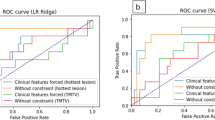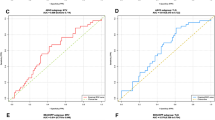Abstract
We have determined the predictive value of [18F]2-fluoro-2-deoxy-glucose (FDG-PET) in patients with Hodgkin's disease (HD) and aggressive non-Hodgkin's lymphoma (NHL) scheduled for high-dose therapy with stem cell transplantation (HDT/SCT). Inclusion criteria were the presence of an FDG-PET scan after chemotherapy (ChT) within 8 weeks prior to HDT/SCT and available follow-up data. Sixteen patients (10 NHL and six HD) were observed during a follow-up period of 4 to 28 months (median 13 months). Before SCT, five patients had a negative PET, three were weakly positive, two moderately positive, and six strongly positive. None of the five patients with a negative PET before HDT/SCT relapsed and two of three patients with a weakly positive scan are still in remission after HDT/SCT. Of eight patients with a moderate or high positive PET before HDT/SCT, seven relapsed and one died of early HDT/SCT related complications (P< 0.01). Three of eight relapsing patients died of lymphoma 5 to 10 months after SCT and in one additional patient not responding to HDT/SCT, the main cause of death was chronic toxicity 4 months after transplantation. After 12 months, in PET-negative patients the overall and relapse-free survival was 100%, in PET-positive patients 55% and 18%, respectively. In NHL, two patients with negative PET, but with an age-adjusted international prognostic index (AaIPI) of 2 and one with AaIPI = 1 are still in remission. In the seven PET-positive subjects, one patient with AaIPI = 0, three with AaIPI = 1, and two with AaIPI = 2 relapsed. We conclude that FDG-PET is accurate in the prediction of relapse prior to HDT/SCT in patients with lymphoma. It provides additional information when compared with the AaIPI.
This is a preview of subscription content, access via your institution
Access options
Subscribe to this journal
Receive 12 print issues and online access
$259.00 per year
only $21.58 per issue
Buy this article
- Purchase on Springer Link
- Instant access to full article PDF
Prices may be subject to local taxes which are calculated during checkout



Similar content being viewed by others
References
Anselmo AP, Meloni G, Cavalieri E, Proia A, Enrici RM, Funaro D, Pescarmona E, Mandelli F . Conventional salvage chemotherapy vs high-dose therapy with autografting for recurrent or refractory Hodgkin's disease patients Ann Hematol 2000 79: 79–82
Philip T, Guglielmi C, Hagenbeek A, Somers R, Van der Lelie H, Bron D, Sonneveld P, Gisselbrecht C, Cahn JY, Harousseau JL et al. Autologous bone marrow transplantation as compared with salvage chemotherapy in relapses of chemotherapy-sensitive non-Hodgkin's lymphoma N Engl J Med 1995 333: 1540–1545
Haioun C, Lepage E, Gisselbrecht C, Bastion Y, Coiffier B, Brice P, Bosly A, Dupriez B, Nouvel C, Tilly H, Lederlin P, Biron P, Briere J, Gaulard P, Reyes F . Benefit of autologous bone marrow transplantation over sequential chemotherapy in poor-risk aggressive non-Hodgkin's lymphoma: updated results of the prospective study LNH87–2. Groupe d'Etude des Lymphomes de l'Adulte J Clin Oncol 1997 15: 1131–1137
Stiff PJ, Dahlberg S, Forman SJ, McCall AR, Horning SJ, Nademanee AP, Blume KG, LeBlanc M, Fisher RI . Autologous bone marrow transplantation for patients with relapsed or refractory diffuse aggressive non-Hodgkin's lymphoma: value of augmented preparative regimens – a Southwest Oncology Group trial J Clin Oncol 1998 16: 48–55
Fanin R, Sperotto A, Ruiz De Elvira C, Zaja F, Stocchi R, Geromin A, Cerno M, Patriarca F, Fanni Canelles M, Damiani D, Baccarani M . A retrospective analysis of 144 patients with aggressive non-Hodgkin's lymphoma: impact of autologous stem cell transplantation in first remission on outcome Haematologica 2000 85: 943–951
Sweetenham JW, Santini G, Qian W, Guelfi M, Schmitz N, Simnett S, Nagler A, Holte H, Kvaloy S, Bruzzi P, Goldstone AH . High-dose therapy and autologous stem-cell transplantation versus conventional-dose consolidation/maintenance therapy as postremission therapy for adult patients with lymphoblastic lymphoma: results of a randomized trial of the European Group for Blood and Marrow Transplantation and the United Kingdom Lymphoma Group J Clin Oncol 2001 19: 2927–2936
Nademanee A, O'Donnell MR, Snyder DS, Schmidt GM, Parker PM, Stein AS, Smith EP, Molina A, Stepan DE, Somlo G et al. High-dose chemotherapy with or without total body irradiation followed by autologous bone marrow and/or peripheral blood stem cell transplantation for patients with relapsed and refractory Hodgkin's disease: results in 85 patients with analysis of prognostic factors Blood 1995 85: 1381–1390
Zinzani PL, Magagnoli M, Franchi R, Zompatori M, Frezza G, Galassi R, Gherlinzoni F, Bendandi M, Albertini P, Monetti N, Tura S . Diagnostic role of gallium scanning in the management of lymphoma with mediastinal involvement Haematologica 1999 84: 604–607
Hill M, Cunningham D, MacVicar D, Roldan A, Husband J, McCready R, Mansi J, Milan S, Hickish T . Role of magnetic resonance imaging in predicting relapse in residual masses after treatment of lymphoma J Clin Oncol 1993 11: 2273–2278
de Wit M, Bumann D, Beyer W, Herbst K, Clausen M, Hossfeld DK . Whole-body positron emission tomography (PET) for diagnosis of residual mass in patients with lymphoma Ann Oncol 1997 8: 57–60
Jerusalem G, Beguin Y, Fassotte MF, Najjar F, Paulus P, Rigo P, Fillet G . Whole-body positron emission tomography using 18F-fluorodeoxyglucose for posttreatment evaluation in Hodgkin's disease and non-Hodgkin's lymphoma has higher diagnostic and prognostic value than classical computed tomography scanimaging Blood 1999 94: 429–433
DeGrado TR, Turkington TG, Williams JJ, Stearns CW, Hoffman JM, Coleman RE . Performance characteristics of a whole-body PET scanner J Nucl Med 1994 35: 1398–1406
Cheson BD, Horning SJ, Coiffier B, Shipp MA, Fisher RI, Connors JM, Lister TA, Vose J, Grillo-Lopez A, Hagenbeek A, Cabanillas F, Klippensten D, Hiddemann W, Castellino R, Harris NL, Armitage JO, Carter W, Hoppe R, Canellos GP . Report of an international workshop to standardize response criteria for non-Hodgkin's lymphomas. NCI Sponsored International Working Group J Clin Oncol 1999 17: 1244–1253
Romer W, Hanauske AR, Ziegler S, Thodtmann R, Weber W, Fuchs C, Enne W, Herz M, Nerl C, Garbrecht M, Schwaiger M . Positron emission tomography in non-Hodgkin's lymphoma: assessment of chemotherapy with fluorodeoxyglucose Blood 1998 91: 4464–4471
Stumpe KD, Urbinelli M, Steinert HC, Glanzmann C, Buck A, von Schulthess GK . Whole-body positron emission tomography using fluorodeoxyglucose for staging of lymphoma: effectiveness and comparison with computed tomography Eur J Nucl Med 1998 25: 721–728
Spaepen K, Stroobants S, Dupont P, Van Steenweghen S, Thomas J, Vandenberghe P, Vanuytsel L, Bormans G, Balzarini J, De Wolf-Peeters C, Mortelmans L, Verhoef G . Prognostic value of positron emission tomography (PET) with fluorine-18 fluorodeoxyglucose J Clin Oncol 2001 19: 414–419
Maisey NR, Hill ME, Webb A, Cunningham D, Flux GD, Padhani A, Ott RJ, Norman A, Bishop L . Are 18fluorodeoxyglucose positron emission tomography and magnetic resonance imaging useful in the prediction of relapse in lymphoma residual masses? Eur J Cancer 2000 36: 200–206
Marsden PK, Ott RJ, Bateman JE, Cherry SR, Flower MA, Webb S . The performance of a multiwire proportional chamber positron camera for clinical use Phys Med Biol 1989 34: 1043–1062
Edwards CL, Hayes RL . Tumor scanning with 67Ga citrate J Nucl Med 1969 10: 103–105
Bogart JA, Chung CT, Mariados NF, Vermont AI, Lemke SM, Grethlein S, Graziano SL . The value of gallium imaging after therapy for Hodgkin's disease Cancer 1998 82: 754–759
Ulusakarya A, Lumbroso J, Casiraghi O, Koscielny S, Vantelon JM, Girinsky T, Tardivon A, Bourhis JH, Dartevelle P, Pico JL, Munck JN . Gallium scan in the evaluation of post chemotherapy mediastinal residual masses of aggressive non-Hodgkin's lymphoma Leuk Lymphoma 1999 35: 579–586
Front D, Bar-Shalom R, Mor M, Haim N, Epelbaum R, Frenkel A, Gaitini D, Kolodny GM, Israel O . Aggressive non-Hodgkinlymphoma: early prediction of outcome with 67Ga scintigraphy Radiology 2000 214: 253–257
Ionescu I, Brice P, Simon D, Guermazi A, Leblanc T, Rousselot P, Gossot D, Meignin V, Gisselbrecht C, Rain JD . Restaging with gallium scan identifies chemosensitive patients and predicts survival of poor-prognosis mediastinal Hodgkin's disease patients Med Oncol 2000 17: 127–134
Willkomm P, Palmedo H, Grunwald F, Ruhlmann J, Biersack HJ . Functional imaging of Hodgkin's disease with FDG-PET and gallium-67 Nuklearmedizin 1998 37: 251–253
Hoh CK, Glaspy J, Rosen P, Dahlbom M, Lee SJ, Kunkel L, Hawkin RA, Maddahi J, Phelps ME . Whole-body FDG-PET imaging for staging of Hodgkin's disease and lymphoma J Nucl Med 1997 38: 343–348
Longo DL, Duffey PL, Young RC, Hubbard SM, Ihde DC, Glatstein E, Phares JC, Jaffe ES, Urba WJ, DeVita VT Jr . Conventional-dose salvage combination chemotherapy in patients relapsing with Hodgkin's disease after combination chemotherapy: the low probability for cure J Clin Oncol 1992 10: 210–218
The International Non-Hodgkin's Lymphoma Prognostic Factors Project. A predictive model for aggressive non-Hodgkin's lymphoma N Engl J Med 1993 329: 987–994
Haioun C, Lepage E, Gisselbrecht C, Salles G, Coiffier B, Brice P, Bosly A, Morel P, Nouvel C, Tilly H, Lederlin P, Sebban C, Briere J, Gaulard P, Reyes F . Survival benefit of high-dose therapy in poor-risk aggressive non-Hodgkin's lymphoma: final analysis of the prospective LNH87–2 protocol – a groupe d'Etude des Lymphomes de l'Adulte study J Clin Oncol 2000 18: 3025–3030
Tarella C, Caracciolo D, Corradini P, Zallio F, Ladetto M, Cuttica A, Rossi G, Novero D, Gavarotti P, Pileri A . Long-term follow-up of advanced-stage low-grade lymphoma patients treated upfront with high-dose sequential chemotherapy and autograft Leukemia 2000 14: 740–747
Moos M, Schulz R, Martin S, Benner A, Haas R . The remission status before and the PCR status after high-dose therapy with peripheral blood stem cell support are prognostic factors for relapse-free survival in patients with follicular non-Hodgkin's lymphoma Leukemia 1998 12: 1971–1976
Olsson K, Gerard CJ, Zehnder J, Jones C, Ramanathan R, Reading C, Hanania EG . Real-time t(11;14) and t(14;18) PCR assays provide sensitive and quantitative assessments of minimal residual disease (MRD) Leukemia 1999 13: 1833–1842
Corradini P, Ladetto M, Pileri A, Tarella C . Clinical relevance of minimal residual disease monitoring in non-Hodgkin's lymphomas: a critical reappraisal of molecular strategies Leukemia 1999 13: 1691–1695
Acknowledgements
This work was supported by the ICP Programme of the Austrian Federal Ministry for Education, Science and Culture and by grant P13984-GEN from the FWF.
Author information
Authors and Affiliations
Rights and permissions
About this article
Cite this article
Becherer, A., Mitterbauer, M., Jaeger, U. et al. Positron emission tomography with [18F]2-fluoro-D-2-deoxyglucose (FDG-PET) predicts relapse of malignant lymphoma after high-dose therapy with stem cell transplantation. Leukemia 16, 260–267 (2002). https://doi.org/10.1038/sj.leu.2402342
Received:
Accepted:
Published:
Issue Date:
DOI: https://doi.org/10.1038/sj.leu.2402342
Keywords
This article is cited by
-
FDG-PET for the early treatment monitoring, for final response and follow-up evaluation in lymphoma
Clinical and Translational Imaging (2015)
-
Current role of FDG PET/CT in lymphoma
European Journal of Nuclear Medicine and Molecular Imaging (2014)
-
The role of 18F-fluorodeoxyglucose positron emission tomography at response assessment after autologous stem cell transplantation in T-cell non-Hodgkin’s lymphoma patients
Annals of Hematology (2013)
-
FDG PET/CT in children and adolescents with lymphoma
Pediatric Radiology (2013)
-
Impact of high-dose chemotherapy followed by auto-SCT for positive interim [18F] FDG-PET diffuse large B-cell lymphoma patients
Bone Marrow Transplantation (2011)



